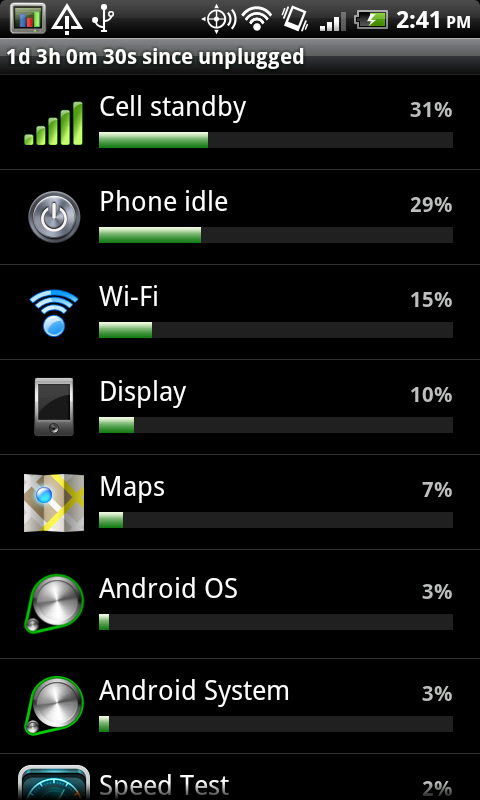HTC Thunderbolt Review: The First Verizon 4G LTE Smartphone
by Brian Klug on April 27, 2011 12:12 AM EST- Posted in
- Smartphones
- HTC
- Verizon
- LTE
- 4G
- Android
- HTC Thunderbolt
- Mobile
- MDM9600
- MSM8655
The other obvious oddity is software. Back in the day HTC famously built their own CDMA2000 support into Android 2.1 1.5 and released a host of devices. Android 2.2 1.6 (Got my versions screwed up, thanks Brendan!) swung around and built all of that in natively, and most of the world didn’t notice much difference, thankfully. Odd quirks such as cell standby showing inordinate power use in "about battery use" were about the only manifestation of this hack, outside phone test menus.

History loves to repeat itself, and this time the situation is that Android 2.2 lacks native awareness for 4G LTE. As a result, you get odd things hanging around like the 20 MB YouTube WiFi upload restriction, and the 128 MB mobile upload (for any connection) file size limitation. I’m sure a number of similar things are floating around, all of which previously pandered to the limitations of 3G that have no business being around anymore.
My closing thoughts with regards to LTE on the Thunderbolt are that it’s impressively fast, fast enough that it now feels like loading through pages is now CPU-bound instead of network-bound. In many ways that’s a much better situation to be in, as SoC updates follow Moore’s law, and network updates seem to eons to roll out due to spectrum reallocation, network build out, testing, and finally hitting go. Dual core is the solution, and it’s a shame the Thunderbolt isn’t. Right up that alley is MSM8960 and MSM8930, which are dual core and single core Krait, respectively. A quick refresher on Qualcomm’s naming scheme for SoCs is that the second digit connotes what cellular network standard support is built in: 2 is for 3GPP family only connectivity (GSM, EDGE, WCDMA/UMTS, HSPA), 6 is for 3GPP and 3GPP2 connectivity (so everything above, plus CDMA2000, EVDO, e.t.c.), and 9 now will mean LTE.
With both MSM8960 and MSM8930, the LTE modem is built into the SoC, resulting in both smaller overall package size and likely notable improvements in power consumption from everything being made at one process. At that point, LTE becomes much less of a design challenge, and I expect battery life to be better as a result. If you want something to wait for, it’s MSM8960. The other thing to watch for are the successors to MDM9600 - the MDM9615 and MDM9625, which were announced during MWC. The former is targeted towards a 28 nm process offers some performance increases alongside reduced power consumption and a smaller overall package, making it ideal for handsets. The latter is a category 4 device (as opposed to category 3 for the former two) and thus offers a higher level of performance, and likely will go into USB modems and other data-centric platforms.










71 Comments
View All Comments
kmmatney - Wednesday, April 27, 2011 - link
One important battery test is how long the phone lasts just sitting around doing nothing, or walking around in a pocket. I can get 3 days out of iPhone 3GS, if I just use it as a phone and not much else.hans007 - Wednesday, April 27, 2011 - link
this or the charge are both pretty similar.the bionic is delayred until at least Q3 . i'm figuring there is probably a reason there are no dual core LTE phones out and they keep getting delayed.
i think either of them is a good choice, if you want to mod your phone, the tbolt is already rooted with several custom roms, and CM7 is already in alpha/beta stage.
HangFire - Wednesday, April 27, 2011 - link
Brian,It's not the BB app but the background services behind it that are persistent, particularly PVWmdrmService. You can kill it but it will come back on next reboot.
The first hit on a Google of Thunderbolt Disable Blockbuster recommends starting and updating the app, and then turning off updates from within the app. While this seems to be good advice as far as data usage goes, it does nothing for preventing the background services from starting and taking up RAM.
Looking forward to what you find on the 8GB issue.
bplewis24 - Wednesday, April 27, 2011 - link
Brian, excellent job with the review. One of my favorite aspects of the review is how you appropriately compared it to different devices in different contexts (design, function, performance, display, etc), instead of always comparing it to the iPhone4 or always comparing it to the Evo, etc.Very objective, informative and practical review, which I realize is a delicate balance.
Kudos,
Brandon
HangFire - Wednesday, April 27, 2011 - link
Just a note, I work in a non-LTE area of MD, and 3G (HRPD I suppose) has been working great all day.pedant - Wednesday, April 27, 2011 - link
"That’s almost exactly double the size"...vision33r - Wednesday, April 27, 2011 - link
Soon, all these Android phones will be 4.5"+ and pushing towards 4.7" and 5.0"synaesthetic - Thursday, April 28, 2011 - link
The 4" screen size with the near-8:5 aspect ratio is absolutely my sweet spot. Software problems aside, I love love LOVED my Galaxy S's screen size. The slightly smaller one on my Glacier just feels a bit cramped.carte247 - Wednesday, April 27, 2011 - link
Good job Brian on the extremely thorough and interesting review. There's always a level of thought and analysis in Anandtech reviews that other sites lack. Or maybe I should be angry, as you're seriously making me consider moving away from my G2 (which up until now I was perfectly happy with...).mlangsottile - Thursday, April 28, 2011 - link
Absolutely fantastic review. Anand Tech is my favorite source for detailed technical analysis of consumer electronics like this. Keep up the good work.